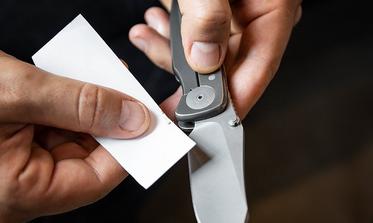What is a detent ball and how do you maintain it?
We hear it quite often: 'I have owned this knife for a while now and it won't run as smoothly as it did before'. Or: 'I just got this knife and it is so stiff'. Many people often immediately use oil to grease the hinge. Yes that could sometimes solve the problem. But what we see is that in many cases there is something else that is causing the problem: the detent ball. We will tell you what that is, what it does and how you can make sure it won't work against you.
What is a detent ball?
The detent ball is a small ball bearing made from steel or ceramics. In knives with a framelock or linerlock a detent ball will make sure that when closed the knife won't accidentally open. The ball is pushed into the lockbar, and in the blade you can find a small hole. Because the detent ball falls into the hole when the knife is closed, the knife will stay closed. In addition to linerlocks and framelocks there are also other mechanisms that use a similar ball (think of a compression lock) but nine out of ten times it concerns a liner or framelock.
Why a detent ball can work against you
When opening and closing the detent ball will continuously come into contact with the blade. With some blades you can, as a result, see traces of this on the blade. You call this the detent track. What happens for most knives is that the detent ball and/or the detent track get dirty. Simply by carrying the blade in your pocket dust already starts to accumulate. Or when during use sand, food or any other filthiness comes in between you immediately notice it. It namely ensures that the smooth and easy contact between the ball and blade is disrupted. As such you feel unevenness so that the hinges no longer move smoothly.
It could also be the case that the detent ball runs 'dry'. This means that there is no longer any oil available to grease the contact between the ball and the detent track. Another cause could be the finish of the blade. With new knives the detent ball needs to be worn in. It needs to have an effect on the blade. Especially when the blade is enhanced with a coating you notice this, but also with a satinized blade you sometimes feel every scratch and groove.
How do you fix it?
If the detent ball or the detent track is dirty the solution is simple: clean it and add a drop of oil. We like to use a cotton swab with a little alcohol to clean the ball, for the detent track you can pull some paper through the frame and the blade. More information about doing this can be found in our topic about how to maintain a pocket knife without taking it apart.
After cleaning it you use an oil pen, the NanoOil 10W, for instance, to add a tiny drop of oil on the ball. By opening and closing the knife a couple of times you spread out the oil over the detent track. Never use too much oil because it will only attract more dust, leaving you with a knife that won't open not long after.
With newer knives it is important to use start using it to be worn in. The ball will polish itself a perfect path, that will work itself out. It is completely normal that a knife needs to be 'worn in' when you start using it. This is true for all moving parts, from a car engine to a hinge in a door.
Conclusion
It is only a simple part of your knife, and the solutions are just as simple. However, it could really affect the way your knife moves. We hope you can now solve most problems yourself. If you have any further questions, please don't hesitate to contact us.










